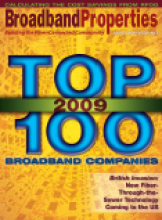Image


The NOFA explicitly calls 768/200 Kbps broadband “sufficient access to broadband service to facilitate rural economic development,” but how many jobs will this kind of broadband really attract to a depressed area? How many new services can service providers sell over such networks? Will the networks support public needs for distance education or health care? And how long will it be before the equipment has to be replaced? In the words of a rural telco manager I spoke with recently, “You want to put money into something long-term if you’re going to start building networks. Don’t build something you’ll have to throw away in two or three years.”Steve Ross takes a look at two networks in Minnesota - the much discussed Monticello FiberNet and a proposed network in Lake County (see Lake County Fiber Network Project FAQ):
Lake County is a rural area in northeastern Minnesota. Its planned network requires 800 miles of fiber to more than 7,300 homes and 500 businesses – every premises in the area that has electricity or telephone service now. It’s the first project of National Public Broadband (www.nationalpublicbroadband.org), a nonprofit helping communities develop and operate municipal fiber networks. NPB’s CEO is Tim Nulty, director of the ECFiber project awaiting funding in Vermont.Steve discusses the crap that TDS is pulling to again prevent competition in Monticello. Despite being laughed (albeit slowly) out of court in their attempt to stop the city from building a fiber network, they are now attempting to incite a bondholder lawsuit by spreading more FUD (fear, uncertainty, and doubt). Interestingly, Steve suggests that TDS' numbers do not add up and that they are advertising fiber services while offering advanced DSL (not that any other private companies have similarly lied). Finally, I recommend "Texas School District Delivers Online Learning Over Fiber." This is another why-rent-when-you-can-own story. Just as many other schools districts have found, they should own the networks rather than lease circuits from private providers. It results in better services at lower prices.
Ultimately, the economic inefficiency of leasing fiber, the anticipation of more bandwidth-intensive interactive learning programs and the proposed expansion of the number of network endpoints led the school district to investigate implementing its own fiber infrastructure. In addition to saving the cost of leasing lines, building its own fiber network enabled the district to have complete control over its network.However, these networks should be built as part of a larger plan. It hardly makes sense for the schools to pay for an entire network that will likely overlap the network other community institutions needs. Therefore, these networks should be built in conjunction with a larger publicly owned network to ensure the entire community can benefit.
